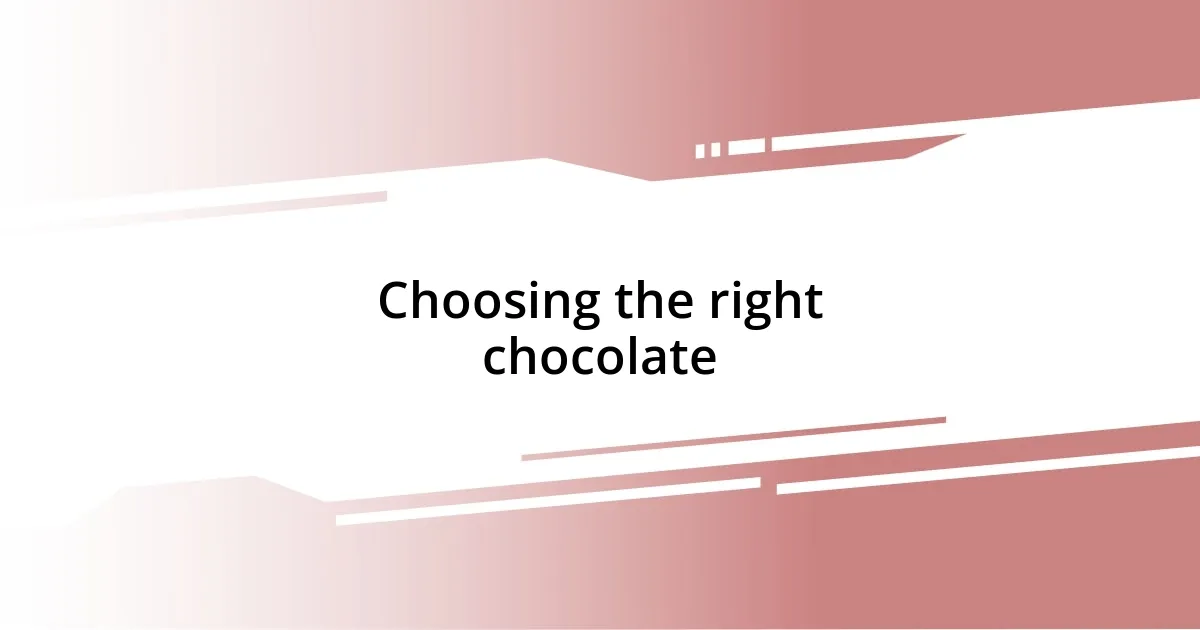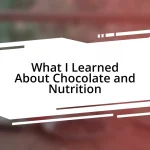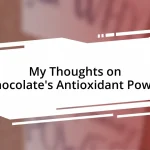Key takeaways:
- High-quality chocolate is crucial for enhancing the flavor of chocolate tarts; experimentation with types and ingredients can make the dessert unique.
- Key steps for preparation include preheating the oven, blind baking the crust, and allowing ganache to cool before filling to achieve the best texture and appearance.
- Common mistakes to avoid include inaccurate ingredient measurement, skipping cooling steps, and failing to balance flavors.
- To maintain freshness, refrigerate leftovers tightly wrapped, and for best results, only freeze the crust before adding ganache.

Introduction to chocolate tarts
Chocolate tarts are more than just a dessert; they’re a slice of indulgence that can transport you to a moment of pure bliss. I remember the first time I took a bite of a rich, velvety chocolate tart—it was like a hug for my taste buds. Have you ever experienced that? The way the smooth chocolate melts against a crumbly crust is simply unforgettable.
These tarts often feature a delicate pastry shell filled with a luscious ganache, made by blending chocolate with cream. I’ve played around with different recipes over the years, and I find that the quality of the chocolate you choose can genuinely elevate the entire dessert. The first time I used dark chocolate instead of semi-sweet, I was amazed at how much depth it brought to the flavor.
What’s fascinating is how chocolate tarts can be both sophisticated and comfortingly familiar at the same time. It’s the kind of dessert that can light up a fancy dinner party or a quiet night in. Have you ever thought about what ingredients make a chocolate tart your own? I often like to experiment, adding a touch of sea salt or a sprinkle of espresso powder to enhance that rich chocolate flavor. There’s just something about those little tweaks that makes it feel even more personal and special.

Ingredients for chocolate tart
The key ingredients for a chocolate tart revolve around creating that perfect balance of flavor and texture. At its core, you’ll need high-quality chocolate—this is crucial. I vividly recall splurging on some artisanal dark chocolate for my first tart, which made all the difference in its richness. For the crust, a blend of flour, butter, and a pinch of salt captures that delightful crunch that complements the smooth filling.
In addition to chocolate and crust components, the ganache requires cream for a silky consistency. Each time I whip up this dessert, I enjoy the calming process of mixing the chocolate and cream until they meld into this decadent mixture. It’s exhilarating to watch it transform right before your eyes. If you’re feeling creative, adding a splash of flavored extract, like vanilla or even orange, can elevate the results.
Don’t forget about sweeteners! While granulated sugar is the standard, I’ve experimented with alternatives like honey or maple syrup, which give a unique twist to the flavor profile. I can’t help but smile recalling the first time I substituted sugar with local honey—it added a wonderful nuance I hadn’t expected. Every ingredient plays a role in creating a well-crafted dessert, allowing for a little personal touch with each attempt.
| Ingredient | Description |
|---|---|
| High-quality chocolate | Forms the rich ganache base, elevating the flavor. |
| Butter | Gives the crust a flaky texture. |
| Flour | Creates the structure of the tart crust. |
| Granulated sugar | Sweetens the tart, balancing the bitterness of the chocolate. |
| Heavy cream | Blends with chocolate for a silky ganache. |
| Sea salt | Enhances the overall flavor profile. |

Choosing the right chocolate
Choosing the right chocolate can significantly influence the final result of your tart. I remember visiting a local chocolate shop, and the intense aroma of cocoa hit me instantly. Each type seemed to call out to me, begging to be selected for my dessert experiment. I left with a bar of high-quality dark chocolate that had a profound flavor profile, and I could hardly wait to see how it performed in my tart.
When selecting chocolate for your tart, consider the following:
- Cocoa Content: Dark chocolate with 60-70% cocoa provides rich depth without being overwhelmingly bitter.
- Flavor Notes: Look for unique flavor profiles, such as fruity or nutty undertones, that can complement your tart.
- Texture: Choose chocolate that melts smoothly; this ensures a silky ganache that tantalizes the palate.
- Brand Reputation: Not all chocolates are created equal. Trust brands known for their quality to ensure the best outcome.
I always find myself rediscovering the joy of chocolate as I experiment. The simple act of melting chocolate and watching it transform into a creamy ganache evokes an excitement that takes me back to my childhood kitchen adventures. The happiness of that experience makes each tart I create a labor of love—one that embodies my passion for flavors and memory.

Step by step tart preparation
Once I’ve gathered my ingredients, it’s time to start the preparation. I begin by preheating the oven to around 350°F (175°C). It’s important to get this step right because a perfectly tempered oven helps achieve that beautiful flaky crust. As I mix butter, flour, and sugar to form the crust dough, I often think about the tactile experience. There’s something incredibly satisfying about kneading the mixture until it resembles fine crumbs—like piecing together a puzzle. Have you ever felt that thrill of creating something from scratch? I notice it every time I prepare the tart.
Next, I press the dough into my tart pan, making sure to create an even layer. The trick here is to avoid overworking the dough, as it can easily become tough. I always take a moment to admire the way it looks in the pan—smooth and inviting—before blind baking it with parchment paper and weights. This step is vital; it prevents the crust from puffing up and ensures a sturdy base for the delicious ganache. I vividly remember the first time I pulled a perfectly baked crust from the oven. The smell was intoxicating, and I couldn’t wait to pour in the chocolate filling.
After the crust has cooled, I prepare the luscious ganache by gently heating the cream and stirring in the chopped chocolate until it melts into a glossy mixture. I find this moment to be pure magic—the transformation speaks to my soul. Incorporating unique flavors like a dash of espresso or a hint of sea salt makes it even more exciting! As I pour this velvety chocolate blend into the prepared crust, I can hardly contain my anticipation. Doesn’t it feel rewarding to create something this delightful? Every step brings me closer to indulging in a sumptuous chocolate tart that I know will leave an unforgettable impression.

Tips for perfect tart crust
When it comes to achieving that perfect tart crust, one essential tip that I’ve learned is to keep everything cold. I always make sure my butter is chilled, and even the flour can benefit from a short stay in the fridge. It creates a tender crust that isn’t tough to bite into. Have you ever experienced the difference between a flakey and a dense crust? It’s remarkable!
Another key aspect is the importance of blind baking. I recall the first time I skipped this step, thinking I could save time. The result? A soggy disaster that left me questioning my choices. Now, I never skip blind baking. The weights keep the dough in place, allowing it to crisp up beautifully. Seeing that golden-brown hue emerge from the oven always gives me a sense of accomplishment; it’s almost like unwrapping a gift I’ve carefully crafted.
Lastly, don’t underestimate the power of resting your dough. I often chill the dough for at least 30 minutes before baking. This step not only relaxes the gluten but also helps prevent shrinkage. I can still remember how thrilled I was the first time I sliced into a tart and found the edges perfectly intact. It brought back memories of my grandmother’s kitchen, where perfection meant paying attention to the simplest details. It truly is these little things that elevate your tart crust to a whole new level!

Common mistakes to avoid
One of the most common mistakes I’ve made when experimenting with chocolate tart is not measuring ingredients accurately. I vividly recall one time when I eyeballed the flour and butter ratios. The result was a crust that crumbled apart the moment I tried to cut into it. Precision matters! Investing in a kitchen scale can make all the difference and is worth every penny if you want consistent results.
Another pitfall I’ve encountered is not allowing the ganache to cool slightly before filling the crust. I remember the anticipation I felt as I poured what I thought was the perfect chocolate filling directly into the still-warm crust. Instead of the smooth, glossy look I envisioned, it turned into a melty mess that seeped into the base. Trust me, patience pays off here; letting the ganache rest for a short while creates a beautifully defined layer that enhances not only the appearance but also the texture.
Lastly, I’ve learned that neglecting the importance of flavor balance can lead to a disappointing tart. On one occasion, I added an overwhelming amount of espresso, thinking it would elevate the chocolate experience. Instead, it completely overshadowed the rich chocolate flavor I sought. Remember, moderation is key! Experimenting is fantastic, but take a moment to consider how each ingredient interacts. What flavors harmonize beautifully? This mindful approach makes for a truly memorable tart!

Serving and storing chocolate tart
When it comes to serving chocolate tart, I always aim to elevate the experience. I’ve found that a simple dusting of cocoa powder or a drizzle of chocolate sauce can transform the presentation. Last year, I served a fresh tart to friends and garnished it with a few raspberries and a sprig of mint. The burst of color not only made the dessert more visually appealing but also added a delightful contrast to the rich chocolate. Have you ever noticed how a little detail can spark excitement?
Storing chocolate tart is another thing I’ve learned the hard way. After a spectacular dinner party, I thought it would be okay to leave leftovers out overnight. The next day, it had lost some of its charm and freshness, which was such a letdown! Now, I wrap any remaining tart tightly in plastic wrap and refrigerate it. This keeps it just as luscious as when it was freshly made. I also find it’s best consumed within three days for optimal texture and taste—there’s nothing worse than a chocolate tart that’s lost its silky consistency.
If you’re contemplating freezing the tart, I’ve got a tip for you! I did this once, thinking I could save some for a later date. While the flavors remained intact, I discovered that the crust wasn’t quite the same after thawing. For the best results, I recommend only freezing the tart before adding the ganache. After defrosting the crust, fill it fresh before serving. It’s a simple trick that keeps every bite heavenly, don’t you think?














